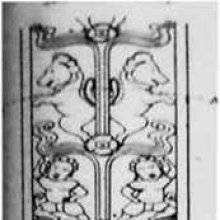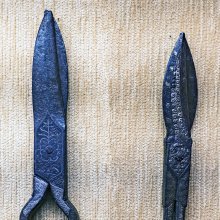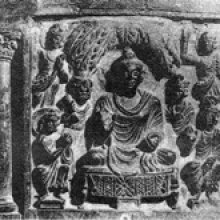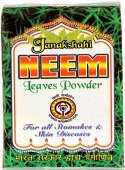Leaf, Leaves: 4 definitions
Introduction:
Leaf means something in Hinduism, Sanskrit. If you want to know the exact meaning, history, etymology or English translation of this term then check out the descriptions on this page. Add your comment or reference to a book if you want to contribute to this summary article.
Images (photo gallery)
(+38 more images available)
In Hinduism
Shaktism (Shakta philosophy)
Source: Brill: Śaivism and the Tantric Traditions (shaktism)Worship of leaves (in Sanskrit: patra) formed a part of the Navarātra Tantric ritual (an autumnal festival of the warrior goddess Caṇḍikā).—The sixth (ṣaṣṭhī) and the seventh (saptamī) lunar days involve awakening the goddess in a bilva tree (bodhana), worship of goddess as Cāmuṇḍā and Kālī in the branch, summoning her nine radiations in nine leaves (navapatrapūjā/patrikāpūjā), enlivening an unfired clay image of the goddess (prāṇapratiṣṭhā).—Various 8th century sources refer to rituals such as the worship of leaves, for example: Devīpurāṇa, Kālikāpurāṇa, Kṛtyakalpataru, Durgābhaktitaraṅgiṇī, Durgāpūjātattva, Durgāpūjāviveka, Bhadrakālīmantravidhiprakaraṇa in Sanderson (2007); account of the Durgā Pūjā in Kelomal, West Bengal (Nicholas 2013).

Shakta (शाक्त, śākta) or Shaktism (śāktism) represents a tradition of Hinduism where the Goddess (Devi) is revered and worshipped. Shakta literature includes a range of scriptures, including various Agamas and Tantras, although its roots may be traced back to the Vedas.
Purana and Itihasa (epic history)
Source: Shodhganga: Elements of Art and Architecture in the Trtiyakhanda of the VisnudharmottarapuranaLeaves (in Sanskrit Śāka) were tradtionally used in the art of cooking, as part of the “sixty four kinds of Art”, according to the Kamasutra of Vatsyayana.—Cf. the Sanskrit Vicitraśākayūṣabhakṣyavikārakriyā.—Indian tradition, basically includes sixty four Art forms are acknowledged. The history of Indian Art covers approximately five thousand years which presents a rich and almost continuous record. The references of sixty four kinds of Kala (कला, kalā) are found in the Bhagavatapurana, Shaiva-Tantras, Kamasutra of Vatsyayana etc.

The Purana (पुराण, purāṇas) refers to Sanskrit literature preserving ancient India’s vast cultural history, including historical legends, religious ceremonies, various arts and sciences. The eighteen mahapuranas total over 400,000 shlokas (metrical couplets) and date to at least several centuries BCE.
Natyashastra (theatrics and dramaturgy)
Source: Shodhganga: Elements of Art and Architecture in the Trtiyakhanda of the Visnudharmottarapurana (natya)Leaves (as found in nature) were commonly used for Ornaments (in Indian Dramas), as conveyed through the Alaṃkāra division of Āhāryābhinaya: one of the four divisions of Abhinaya or “ways to convey or represent one’s emotion to others”, according to the Viṣṇudharmottarapurāṇa, an ancient Sanskrit text which (being encyclopedic in nature) deals with a variety of cultural topics such as arts, architecture, music, grammar and astronomy.—In the Sanskrit dramas ornaments like ear-rings, bracelets, head-gears etc. are seen to be collected from nature. This is informed in many of the Sanskrit dramas. In the Abhijñānaśakuntala, as for example, Śakuntalā is seen to wear flowers, leaves etc. as her ornaments. She is also seen to remain dependant upon nature for her garments. She was wearing the skin of tree as her daily garment. Her clothes were supplied by trees.

Natyashastra (नाट्यशास्त्र, nāṭyaśāstra) refers to both the ancient Indian tradition (shastra) of performing arts, (natya—theatrics, drama, dance, music), as well as the name of a Sanskrit work dealing with these subjects. It also teaches the rules for composing Dramatic plays (nataka), construction and performance of Theater, and Poetic works (kavya).
Shilpashastra (iconography)
Source: Shodhganga: Elements of Art and Architecture in the Trtiyakhanda of the Visnudharmottarapurana (shilpa)Leaves refers to class of natural objects and phenomenon which follows specific guidelines in the tradition of ancient Indian Painting (citra), according to the Viṣṇudharmottarapurāṇa, an ancient Sanskrit text which (being encyclopedic in nature) deals with a variety of cultural topics such as arts, architecture, music, grammar and astronomy.—From the ancient period till today, many natural objects [like leaves, ...] always seem to inspire the artist to make beautiful creations. Even the sages in the Vedic period used to see the surroundings and could visualise everything as portraits in the mind. The Viṣṇudharmottarapurāṇa bears an elaborate description on the process of making the picture of some natural objects and phenomenon, e.g., Leaves. Thus, the book addresses various elements of nature, such as a Leaf, since painting has much connection with time, mood and activity.

Shilpashastra (शिल्पशास्त्र, śilpaśāstra) represents the ancient Indian science (shastra) of creative arts (shilpa) such as sculpture, iconography and painting. Closely related to Vastushastra (architecture), they often share the same literature.
See also (Relevant definitions)
Starts with: Leaf beet, Leaf of life, Leafless milkweed, Leafless wormbush, Leafy arnica, Leafy bog aster, Leafy cup, Leafy fleabane, Leafy milkwort, Leafy rayless aster, Leafy rock isotome, Leafy spurge, Leafy tussock sedge, Leafy-flowered ipomoea, Leafy-stemmed plantain.
Ends with (+67): Adda leaf, Apple-leaf, Arrow-leaf, Balm leaf, Bayangi bitterleaf, Beauty leaf, Betel leaf, Big yellow velvetleaf, Bitter leaf, Bitterleaf, Bloodleaf, Bluntleaf waterleaf, Broad-leaf water-leaf, Broadleaf, Caracas big-leaf, Cochinchina sweetleaf, Copperleaf, Cork leaf, Cotton leaf, Cowfoot leaf.
Full-text (+4749): Parna, Tambula, Nimba, Utaja, Pallava, Sahotaja, Tulasi, Palasha, Parnotaja, Aparna, Puta, Parnakuti, Dala, Arka, Asipatravana, Parnakricchra, Khandapatra, Samstara, Pinjola, Parnashana.
Relevant text
Search found 415 books and stories containing Leaf, Leaves; (plurals include: Leaves, Leaveses). You can also click to the full overview containing English textual excerpts. Below are direct links for the most relevant articles:
Bhesajjakkhandhaka (Chapter on Medicine) (by Hin-tak Sik)
Medicines (c): Leaves (Paṇṇa/Patra) < [Chapter 4 - Medicinal Substances in the Chapter on Medicine]
Medicines (a): Roots (Mūla) < [Chapter 4 - Medicinal Substances in the Chapter on Medicine]
Chapter Summary < [Chapter 4 - Medicinal Substances in the Chapter on Medicine]
Varahi Tantra (English Study) (by Roberta Pamio)
Chapter 8 - Āpadūddharaṇa Kavaca (a hymn dedicated to Kālī) < [Summary of the Vārāhī Tantra]
Chapter 12 - The Dhyānas (supports for the meditation) of the Goddess < [Summary of the Vārāhī Tantra]
Rasa Jala Nidhi, vol 4: Iatrochemistry (by Bhudeb Mookerjee)
Part 13 - Chewing of betel leaves < [Chapter I - General health prescriptions]
Treatment for fever (162): Shitaghna rasa < [Chapter II - Fever (jvara)]
Treatment for fever (12): Lokendra rasa < [Chapter II - Fever (jvara)]
Kathasaritsagara (the Ocean of Story) (by Somadeva)
Part 1 - Betel-Chewing in India prior to a.d. 1800 < [Appendix 8.2 - The Romance of Betel-Chewing]
Part 2 - Northern and Central India < [Appendix 8.2 - The Romance of Betel-Chewing]
Part 3 - Southern India < [Appendix 8.2 - The Romance of Betel-Chewing]
Folklore of the Santal Parganas
Chapter CLXVII - Hares and Men < [Part V]
Chapter CLXVIII - A Legend < [Part V]
Chapter XVI - The Miser’s Servant < [Part I]
The Skanda Purana (by G. V. Tagare)
Chapter 8 - The Greatness of Tulasī < [Section 5 - Mārgaśīrṣa-māhātmya]
Chapter 210 - Importance of Tāmbūla < [Section 1 - Tīrtha-māhātmya]
Chapter 250 - Creation of Bilva Tree < [Section 1 - Tīrtha-māhātmya]
Related products
(+152 more products available)











